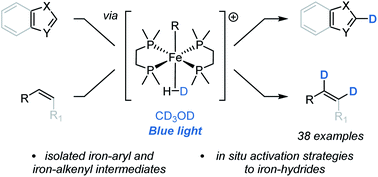Iron-catalysed alkene and heteroarene H/D exchange by reversible protonation of iron-hydride intermediates†
Abstract
C–H functionalisation reactions offer a sustainable method for molecular construction and diversification. These reactions however remain dominated by precious metal catalysis. While significant interest in iron-catalysed C–H activation reactions has emerged, the isolation, characterisation and mechanistic understanding of these processes remain lacking. Herein the iron-catalysed C(sp2)–H bond hydrogen/deuterium exchange reaction using CD3OD is reported for both heterocycles and, for the first time, alkenes (38 examples). Isolation and characterisation, including by single-crystal X-ray diffraction, of the key iron-aryl and iron-alkenyl C–H metallation intermediates provided evidence for a reversible protonation of the active iron hydride catalyst. Good chemoselectivity was observed for both substrate classes. The developed procedure is orthogonal to previous iron-catalysed H/D exchange methods which used C6D6, D2, or D2O as the deuterium source, and uses only bench-stable reagents, including the iron(II) pre-catalyst. Further, a new mechanism of iron-hydride formation is reported in which β-hydride elimination from an alcohol generates the iron hydride. The ability to produce, isolate and characterise the organometallic products arising from C–H activation presents a basis for future discovery and development.

- This article is part of the themed collection: 2022 Chemical Science HOT Article Collection


 Please wait while we load your content...
Please wait while we load your content...